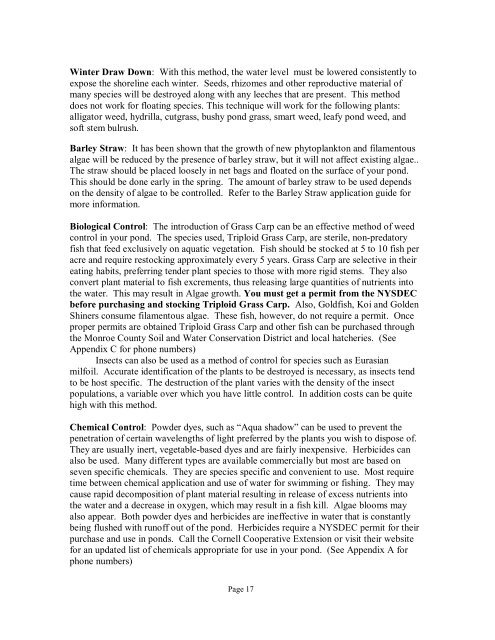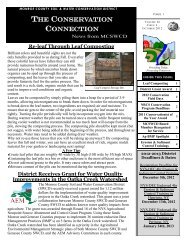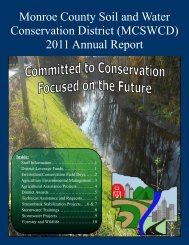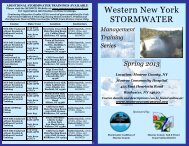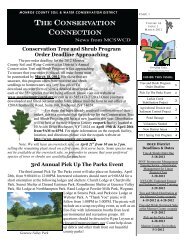Pond Uses, Site Selection, Design, Construction, and Maintenance
Pond Uses, Site Selection, Design, Construction, and Maintenance
Pond Uses, Site Selection, Design, Construction, and Maintenance
You also want an ePaper? Increase the reach of your titles
YUMPU automatically turns print PDFs into web optimized ePapers that Google loves.
Winter Draw Down: With this method, the water level must be lowered consistently to<br />
expose the shoreline each winter. Seeds, rhizomes <strong>and</strong> other reproductive material of<br />
many species will be destroyed along with any leeches that are present. This method<br />
does not work for floating species. This technique will work for the following plants:<br />
alligator weed, hydrilla, cutgrass, bushy pond grass, smart weed, leafy pond weed, <strong>and</strong><br />
soft stem bulrush.<br />
Barley Straw: It has been shown that the growth of new phytoplankton <strong>and</strong> filamentous<br />
algae will be reduced by the presence of barley straw, but it will not affect existing algae..<br />
The straw should be placed loosely in net bags <strong>and</strong> floated on the surface of your pond.<br />
This should be done early in the spring. The amount of barley straw to be used depends<br />
on the density of algae to be controlled. Refer to the Barley Straw application guide for<br />
more information.<br />
Biological Control: The introduction of Grass Carp can be an effective method of weed<br />
control in your pond. The species used, Triploid Grass Carp, are sterile, non-predatory<br />
fish that feed exclusively on aquatic vegetation. Fish should be stocked at 5 to 10 fish per<br />
acre <strong>and</strong> require restocking approximately every 5 years. Grass Carp are selective in their<br />
eating habits, preferring tender plant species to those with more rigid stems. They also<br />
convert plant material to fish excrements, thus releasing large quantities of nutrients into<br />
the water. This may result in Algae growth. You must get a permit from the NYSDEC<br />
before purchasing <strong>and</strong> stocking Triploid Grass Carp. Also, Goldfish, Koi <strong>and</strong> Golden<br />
Shiners consume filamentous algae. These fish, however, do not require a permit. Once<br />
proper permits are obtained Triploid Grass Carp <strong>and</strong> other fish can be purchased through<br />
the Monroe County Soil <strong>and</strong> Water Conservation District <strong>and</strong> local hatcheries. (See<br />
Appendix C for phone numbers)<br />
Insects can also be used as a method of control for species such as Eurasian<br />
milfoil. Accurate identification of the plants to be destroyed is necessary, as insects tend<br />
to be host specific. The destruction of the plant varies with the density of the insect<br />
populations, a variable over which you have little control. In addition costs can be quite<br />
high with this method.<br />
Chemical Control: Powder dyes, such as “Aqua shadow” can be used to prevent the<br />
penetration of certain wavelengths of light preferred by the plants you wish to dispose of.<br />
They are usually inert, vegetable-based dyes <strong>and</strong> are fairly inexpensive. Herbicides can<br />
also be used. Many different types are available commercially but most are based on<br />
seven specific chemicals. They are species specific <strong>and</strong> convenient to use. Most require<br />
time between chemical application <strong>and</strong> use of water for swimming or fishing. They may<br />
cause rapid decomposition of plant material resulting in release of excess nutrients into<br />
the water <strong>and</strong> a decrease in oxygen, which may result in a fish kill. Algae blooms may<br />
also appear. Both powder dyes <strong>and</strong> herbicides are ineffective in water that is constantly<br />
being flushed with runoff out of the pond. Herbicides require a NYSDEC permit for their<br />
purchase <strong>and</strong> use in ponds. Call the Cornell Cooperative Extension or visit their website<br />
for an updated list of chemicals appropriate for use in your pond. (See Appendix A for<br />
phone numbers)<br />
Page 17


